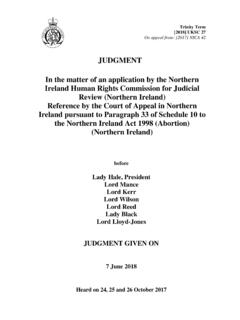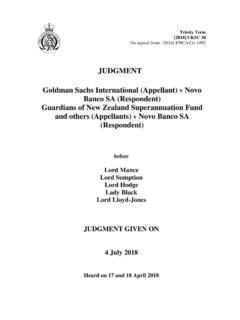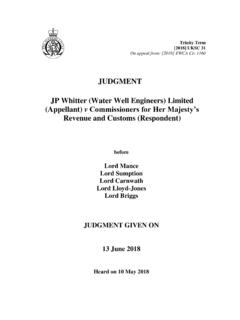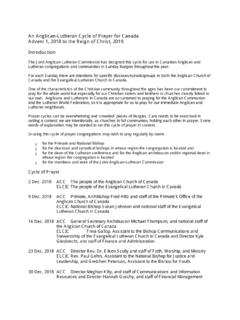Transcription of Pimlico Plumbers Ltd and another (Appellants) v …
1 trinity Term [ 2018 ] UKSC 29 On appeal from: [ 2017 ] EWCA Civ 51 JUDGMENT Pimlico Plumbers Ltd and another (Appellants) v Smith (Respondent) before Lady Hale, President Lord Wilson Lord Hughes Lady Black Lord Lloyd-Jones JUDGMENT GIVEN ON 13 June 2018 Heard on 20 and 21 February 2018 Appellants Respondent Thomas Linden QC Karon Monaghan QC Akash Nawbatt QC David Stephenson (Instructed by Mishcon de Reya LLP) (Instructed by TMP Solicitors LLP) Page 2 LORD WILSON: (with whom Lady Hale, Lord Hughes, Lady Black and Lord Lloyd-Jones agree) INTRODUCTION 1. Between August 2005 and April 2011 Mr Smith, the respondent, who is by trade a plumbing and heating engineer, did work for Pimlico Plumbers Ltd ( Pimlico ), the first appellant, which conducts a substantial plumbing business in London.
2 Mr Mullins, the second appellant, owns Pimlico . 2. In August 2011 Mr Smith issued proceedings against Pimlico and Mr Mullins in an employment tribunal ( the tribunal ). He alleged (a) that he had been an employee of Pimlico under a contract of service within the meaning of section 230(1) of the Employment Rights Act 1996 ( the Act ) and as such he complained, among other things, that Pimlico had dismissed him unfairly contrary to section 94(1) of it; and/or (b) that he had been a worker for Pimlico within the meaning of section 230(3) of the Act and as such he complained that Pimlico had made an unlawful deduction from his wages contrary to section 13(1) of it; and (c) that he had been a worker for Pimlico within the meaning of regulation 2(1) of the Working Time Regulations 1998 (SI 1998/1833) ( the Regulations ) and as such he complained that Pimlico had failed to pay him for the period of his statutory annual leave contrary to regulation 16 of them; and (d) that he had been in Pimlico s employment within the meaning of section 83(2)(a) of the Equality Act 2010 ( the Equality Act ) and as such he complained that both Pimlico and Mr Mullins had discriminated against him by reference to disability contrary to section 39(2) of it and had failed to make reasonable adjustments in that regard contrary to section 39(5) of it.
3 3. By a judgment dated 16 April 2012 delivered by Employment Judge Corrigan ( the judge ), the tribunal decided that Mr Smith had not been an employee of Pimlico under a contract of service; and, by a judgment dated 21 November 2014 Page 3 delivered by Judge Serota QC, the Employment Appeal Tribunal ( the appeal tribunal ) dismissed Mr Smith s cross-appeal against that decision. He has not sought further to challenge it. The result is that he cannot proceed with the complaints referred to in para 2(a) above. 4. Nevertheless, by that same judgment dated 16 April 2012, the tribunal made three further decisions: (a) that Mr Smith had been a worker for Pimlico within the meaning of section 230(3) of the Act; (b) that he had been a worker for Pimlico within the meaning of regulation 2(1) of the Regulations; and (c) that he had been in Pimlico s employment within the meaning of section 83(2)(a) of the Equality Act.
4 Were the decisions on these three threshold issues to be upheld, the result would be that Mr Smith could proceed with the complaints referred to in para 2(b), (c) and (d) above. Indeed the tribunal made directions for their substantive consideration. 5. Pimlico brought an appeal against the tribunal s three further decisions to the appeal tribunal, which dismissed it by that same judgment dated 21 November 2014. Pimlico thereupon brought an appeal against the appeal tribunal s decision to the Court of Appeal, which on 10 February 2017 , by substantive judgments delivered by Sir Terence Etherton MR and Underhill LJ and by a judgment of Davis LJ which agreed with both of them, dismissed it ([ 2017 ] ICR 657). 6. Today this court determines Pimlico s yet further appeal, which is in form a challenge to the decision of the Court of Appeal but which is in substance a further inquiry into the entitlement of the tribunal to have made the three decisions referred to in para 4 above.
5 Pimlico argues that the tribunal s reasoning in support of them was inadequate and it asks the court to set them aside and to direct the tribunal to reconsider the three threshold issues. 7. It follows that the tribunal held that, although Mr Smith was not an employee under a contract of service, he was an employee within the meaning of section 83(2)(a) of the Equality Act. It is regrettable that in this branch of the law the same word can have different meanings in different contexts. But it gets worse. For, as I will explain, different words can have the same meaning. 8. As long ago as 1875 Parliament identified an intermediate category of working people falling between those who worked as employees under a contract of service and those who worked for others as independent contractors.
6 For in that year it passed the Employers and Workmen Act, designed to give the county court an enlarged and flexible jurisdiction in disputes between an employer and a workman ; and, by section 10, it defined a workman as, in effect, a manual labourer working for an employer under a contract of service or a contract personally to execute any work or labour . Page 4 9. From 1970 onwards Parliament has taken the view that, while only employees under a contract of service should have full statutory protection against various forms of abuse by employers of their stronger economic position in the relationship, there were self-employed people whose services were so largely encompassed within the business of others that they should also have limited protection, in particular against discrimination but also against certain forms of exploitation on the part of those others; and for that purpose Parliament has borrowed and developed the extended definition of a workman first adopted in 1875.
7 10. Thus in 1970 Parliament passed the Equal Pay Act which obliged employers to offer to any woman whom they employed terms equal to those upon which they employed men for the same or equivalent work; and, by section 1(6)(a), it defined the word employed as being under a contract of service or of apprenticeship or a contract personally to execute any work or labour . Then, in section 167(1) of the Industrial Relations Act 1971, we find the birth of the modern worker , defined there as a person who works (a) under a contract of employment, or (b) under any other contract .. whereby he undertakes to perform personally any work or services for another party to the contract who is not a professional client of his .. 11. Now we have section 230(3) of the Act, in which a worker is defined to include not only, at (a), an employee under a contract of service but also, at (b), an individual who has entered into or works under any other contract.
8 Whereby the individual undertakes to .. perform personally any work or services for another party to the contract whose status is not by virtue of the contract that of a client or customer of any profession or business undertaking carried on by the individual .. Other subsections of section 230, to which thankfully it will be unnecessary to refer, proceed to extend the words employee , employment and employed to the situation of a worker falling within subsection (3)(b) and conveniently described as a limb (b) worker. 12. Regulation 2(1) of the Regulations defines a worker in terms identical to those in section 230(3) of the Act. 13. On its face section 83(2)(a) of the Equality Act defines employment in terms different from those descriptive of the concept of a worker under section 230(3) of the Act and under regulation 2(1) of the Regulations.
9 For it defines it as Page 5 being either under a contract of employment or of apprenticeship or under a contract personally to do work . Comparison of the quoted words with the definition of a limb (b) worker in section 230(3) of the Act demonstrates that, while the obligation to do the work personally is common to both, the Equality Act does not expressly exclude from the concept a contract in which the other party has the status of a client or customer. 14. As it happens, however, this distinction has been held to be one without a difference. Part 5 of the Equality Act, which includes section 83, primarily gives effect to EU law. Article 157(1) of the Treaty on the Functioning of the European Union requires member states to ensure application of the principle of equal pay for male and female workers for equal work or work of equal value.
10 In Allonby v Accrington and Rossendale College (Case C-256/01) [2004] ICR 1328 the Court of Justice of the European Communities, at paras 67 and 68, interpreted the word workers in what is now article 157(1) as persons who perform services for and under the direction of another person in return for which [they receive] remuneration but excluding independent providers of services who are not in a relationship of subordination with the person who receives the services . In Hashwani v Jivraj [2011] UKSC 40, [2011] 1 WLR 1872, the Supreme Court applied the concepts of direction and subordination identified in the Allonby case to its interpretation of a contract personally to do.













